Lights, camera, real-time 3D action

(PhysOrg.com) -- The 3D movies on today's cinema screens rely on visual tricks to cope with fast action. A new generation, produced at lower cost but delivering higher quality with real-time action, is soon to follow.
The cost to produce digital movies will be slashed by a streamlined and standardised way of taking movie images from the camera through post-production phases and onto cinema screens, thanks to work by European researchers.
Digital movies go through a series of post-production steps after they are shot to add or adjust special effects, or to correct the colours, sound or the picture balance. Special equipment and software has been developed for each step - but there has been no agreed industry standard on the image file format for post-production. As the digital file is decompressed, modified and recompressed at each stage, valuable data can be lost.
A prototype camera developed for a research project called EDCINE records - alongside the images - metadata on the settings of the camera and its position, plotted from GPS. By shooting in JPEG 2000 format and using that format at every stage through post-production, that metadata remains intact. Data that ‘watermarks’ the cinema image and sound files to protect against piracy or data that carries multilingual subtitles can be carried through the process in the same way.
Researchers on the EDCINE project are leading the way in handling high-quality, high-throughput and high-value data streams for digital cinema. By moving away from proprietary technology to interoperable technology using the shared JPEG 2000 standard, the EDCINE team showed a way to reduce post-production equipment manufacturing and development costs.
The advantage of the wavelet-based JPEG 2000 compression format is that it allows frame-by-frame multilevel access for single frame editing, and the JPEG 2000 files can be decompressed and recompressed without loss of data. At the end of production, the image can even be compressed a little more for electronic transmission to cinemas which helps with distribution.
Preserving the quality of older films when digitising them to the JPEG 2000 standard was another focus of the EU-funded project.
“The idea is to streamline the transmission of the image within the production process using a lossless variant of JPEG 2000 compression,” explains Benoit Michel, EDCINE project manager from the Université Catholique de Louvain (UCL), Belgium.
“If you do it properly you don’t lose any metadata accompanying the image. It always comes back to the question of money. Greater interoperability means less problems and less costs along the whole production chain.”
The EDCINE team’s work is influencing movie industry development right around the world. IntoPIX, a spin off company from UCL has provided JPEG 2000 decoders to 80 percent of the cinemas equipped for digital movies worldwide.
Fast action 3D
EDCINE researchers also played a leading role in amending industry standards to meet the requirements of the next generation of fast-action 3D cinema blockbusters. The arrival of 3D has boosted cinema viewer’s interest in the ongoing digital revolution. But movies like the recent Hollywood blockbuster Avatar are an intermediate step. They are projected at the industry standard 24 frames per second which is not considered good enough for fast movements, and it is more noticeable in 3D than in 2D. Movie-makers are forced to use visual tricks, such as blurring backgrounds to make objects appear to be travelling more rapidly than they are.
If movies are to be shot and projected at faster frame rates, then equipment manufacturers need standards agreed industry-wide to optimise quality, robustness to transmission errors, content security, and stereoscopic imaging, amongst other things. The EDCINE team completed much of the groundwork for amendment to the industry’s DCI standards at higher speeds, up to 60 frames per second.
Members of the EDCINE team are now tackling some of the challenges in 3D image making for live transmission. At present, the vertical differences between the left and right images that come together to make a 3D image need to be corrected by hand in post-production, a slow and costly process. The team aims to find solutions to enable stereoscopic cinema to run in real time at good quality.
More information: EDCINE project - www.edcine.org/
Provided by ICT Results

















